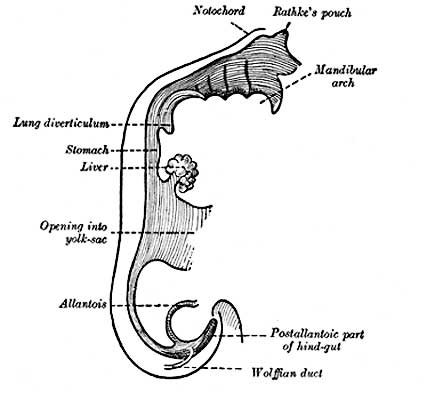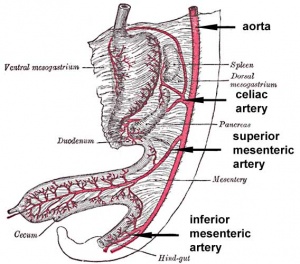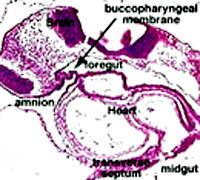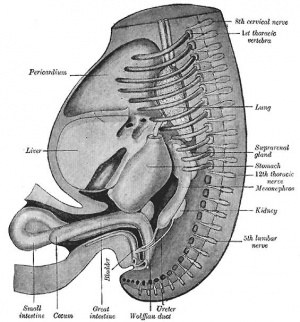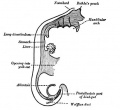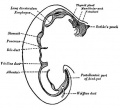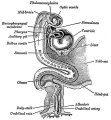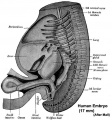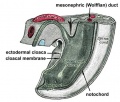Gastrointestinal Tract Development: Difference between revisions
| Line 172: | Line 172: | ||
==Additional Images== | ==Additional Images== | ||
<gallery> | <gallery> | ||
File:Gitbpm.jpg | |||
File:Gray0982a.jpg | |||
File:Gray0982b.jpg | |||
File:Gray0977.jpg | |||
File:Gray0986.jpg | |||
File:Gray0986.jpg | |||
File:Git17mm.jpg|Historic image showing midgut herniation | File:Git17mm.jpg|Historic image showing midgut herniation | ||
File:Gray0991.jpg | |||
File:Stage14-git.jpg | |||
File:Human_Embryo_17.8mm_GIT.jpg|Historic human embryo (17.8mm) | |||
File:Human_Embryo_17.8mm_a_CNS_GIT.jpg|Historic human embryo (17.8mm) | |||
File:Human_Embryo_17.8mmCNS_GIT.jpg|Historic human embryo (17.8mm) | |||
</gallery> | </gallery> | ||
Revision as of 09:17, 23 July 2010
Introduction
The gastrointestinal tract (GIT) extending from the buccopharyngeal membrane to the cloacal membrane arises initially from the endoderm of the trilaminar embryo (week 2, 3). It later has contributions from all the germ cell layers.
During the 4th week the 3 distinct portions (fore-, mid- and hind-gut) extend the length of the embryo and will contribute different components of the GIT. The large mid-gut is generated by lateral embryonic folding which "pinches off" a pocket of the yolk sac, the 2 compartments continue to communicate through the vitelline duct. On this current page there is a brief developmental overview and stage 13/14 embryo overview.
The oral cavity (mouth) is formed following breakdown of the buccopharyngeal membrane (oropharyngeal or oral) and contributed to mainly by the pharynx lying within the pharyngeal arches. The opening of the GIT means that it contains amniotic fluid, which is also swallowed later in development. (More? Taste | Head and Neck Development - Tongue)
From the oral cavity the next portion of the foregut is initially a single gastrointestinal (oesophagus) and respiratory (trachea) common tube, the pharynx which lies behind the heart. Note that the respiratory tract will form from a ventral bud arising at this level (More? Respiratory)
--Mark Hill 09:25, 14 April 2010 (EST) Page Template only - content from original UNSW Embryology site currently being edited and updated.
| System Links: Introduction | Cardiovascular | Coelomic Cavity | Endocrine | Gastrointestinal Tract | Genital | Head | Immune | Integumentary | Musculoskeletal | Neural | Neural Crest | Placenta | Renal | Respiratory | Sensory | Birth |
Some Recent Findings
Textbooks
- Human Embryology Larson Chapter 9 p229-260
- The Developing Human: Clinically Oriented Embryology (6th ed.) Moore and Persaud Chapter 12 p271-302
- Before We Are Born (5th ed.) Moore and Persaud Chapter 13 p255-287
- Essentials of Human Embryology Larson Chapter 9 p123-146
- Human Embryology Fitzgerald and Fitzgerald Chapter 19,20 p119-123
- Anatomy of the Human Body 1918 Henry Gray 2. The Digestive Apparatus
Objectives
- Understanding of germ layer contributions to the early gastrointestinal tract (GIT)
- Understanding of the folding of the GIT
- Understanding of three main GIT embryonic divisions
- Understanding of associated organ development (liver, pancreas, spleen)
- Brief understanding of mechanical changes (rotations) during GIT development
- Brief understanding of gastrointestinal abnormalities
Germ Layer Contributions
- Endoderm - epithelium and associated glands
- Mesoderm (splanchnic) - mesentry, connective tissues, smooth muscle, blood vessels
- Ectoderm (neural crest) - enteric nervous system (neural tube) - extrinsic innervation
Both endoderm and mesoderm will contribute to associated organs.
3 GIT divisions
During the 4th week the 3 distinct portions (fore-, mid- and hind-gut) extend the length of the embryo and will contribute different components of the GIT. These 3 divisions are also later defined by the vascular (artery) supply to each of theses divisions.
The large mid-gut is generated by lateral embryonic folding which "pinches off" a pocket of the yolk sac, the 2 compartments continue to communicate through the vitelline duct.
The oral cavity (mouth) is formed following breakdown of the buccopharyngeal membrane (oropharyngeal, oral membrane) and contributed to mainly by the pharynx lying within the pharyngeal arches. The opening of the GIT means that it contains amniotic fluid, which is also swallowed later in development.
Foregut
From the oral cavity the next portion of the foregut is initially a single gastrointestinal (oesophagus) and respiratory (trachea) common tube, the pharynx which lies behind the heart. Note that the respiratory tract will form from a ventral bud arising at this level.
- Oral cavity
- Pharynx (esophagus, trachea)
- Respiratory tract
- Stomach
Midgut
From beneath the stomach the initial portion of the small intestine, the duodenum, and the associated pancreas now lie.
Much of the midgut is herniated at the umbilicus external to the abdomen through development. A key step in development is the rotation of this midgut that must occur to place the GIT in the correct abdominal position with its associated mesentry. The GIT itself differentiates to form significantly different structures along its length: oesophagus, stomach, duodenum, jejunum, iliem (small intestine), colon (large intestine). (More? [git13.htm Intestine Development])
The mesentries of the GIT are generated from the common dorsal mesentry, with the ventral mesentry contributing to the lesser omentum and falciform ligament.
Hindgut
The distral transverse colon, descending colon, sigmoid colon, rectum and cloaca. The cloaca is the common urogenital sinus which will later become partitioned into an anterior urinary and posterior GIT rectal component.
Reading
- Human Embryology (2nd ed.) Larson Ch9 p229-260
- The Developing Human: Clinically Oriented Embryology (6th ed.) Moore and Persaud Ch 12 p271-302
- Before We Are Born (5th ed.) Moore and Persaud Ch13 p255-287
- Essentials of Human Embryology Larson Ch 9 p123-146
- Human Embryology Fitzgerald and Fitzgerald Ch19,20 p119-123
Development Overview
GIT shown in green anchored by dosal and ventral mesogastrium. The space ouside this will be the peritoneal cavity.
Red ring-neural tube with neural crestBlue ring- notocordOrange- somites
Differentiation of associated organs at the level of the forming stomach occurs both dorsally (spleen) and ventrally (liver).
Large blue ring- dorsal aortaDark green ring- Liver
Continued growth of the GIT and the organs leads to organ movements and bending of tract.
Other Images: [git5.htm#gitrotate Simple cartoon of GIT Rotation] | [git10.htm#Greater_Omentum Greater Omentum] | [git10.htm#Duodenum/Pancreas_Rotation Duodenum/Pancreas Rotation] |
Carnegie stage 13/14 Embryo (Pig) Overview
Below is an overview of the sections starting at the level of pharynx compressed dorsoventrally, following the GIT through to the rectum. The most obvious feature is that of a continuous tube initially, attached by dorsoventral mesentry. Outside this tube and mesentry (at the levels below the lung buds) is the intraembryonic coelom that will form the peritoneal cavity. The hepatic diverticulum (liver bud) lies under the septum transversum is the earliest associated GIT organ that has differentiated, and now occupies a substantial region of the abdomen. A full description of each image is on the [git3.htm#Pig stage13/14 page.] Clicking on sections below will open the original images.
| File:Git.gif | |||
| Bifurcation of the pharynx into anterior respiratory and posterior oesophagous. | The stomach forming beneath the lung buds and adjacent to the developing liver. | Below the stomach the GIT has a large dorsal mesogastrium and finer ventral mesogastrium. Associated with the tract is the large portal blood vessel derived from the vitelline circulation. | At the bottom curvature of the embryo the mesentry association with the GIT shows extensive vitelline vessels running out through the umbilicus. The hindgut can then be seen, ending at the common urogenital sinus, the cloaca. |
Gastrointestinal Tract Abnormalities
Lumen Abnormalities
There are several types of abnormalities that impact upon the continuity of the gastrointestinal tract lumen.
- Atresia - interuption of the lumen (esophageal atresia, duodenal atresia, extrahepatic biliary atresia, anorectal atresia)
- Stenosis - narrowing of the lumen (duodenal stenosis, pyloric stenosis).
- Duplication - incomplete recanalization resulting in parallel lumens, this is really a specialized form of stenosis.
Meckel's Diverticulum
This GIT abnormality is a very common and results from improper closure and absorption of the omphalomesenteric duct (vitelline duct) in development. This transient developmental duct connects the yolk to the primitive GIT.
Intestinal Malrotation
Intestinal Aganglionosis
(intestinal aganglionosis, Hirschsprung's disease, aganglionic colon, megacolon, congenital aganglionic megacolon, congenital megacolon) A condition caused by the lack of enteric nervous system (neural ganglia) in the intestinal tract responsible for gastric motility (peristalsis).
MH - will cover again in neural crest lecture.
Gastroschisis
Gastroschisis (omphalocele, paraomphalocele, laparoschisis, abdominoschisis, abdominal hernia) is a congenital abdominal wall defect which results in herniation of fetal abdominal viscera (intestines and/or organs) into the amniotic cavity. Incidence of gastroschisis has been reported at 1.66/10,000, occuring more frequently in young mothers (less than 20 years old). By definition, it is a body wall defect, not a gastrointestinal tract defect, which in turn impacts upon GIT development.
References
Online Textbooks
- Developmental Biology (6th ed) Gilbert, Scott F. Sunderland (MA): Sinauer Associates, Inc.; c2000. The Digestive Tube and Its Derivatives | Endodermal development of a human embryo
- Search NLM Online Textbooks "gastrointestinal tract" : Developmental Biology | Endocrinology | Molecular Biology of the Cell | The Cell- A molecular Approach
Reviews
- <pubmed>18416699</pubmed>
- <pubmed>17284768</pubmed>
- <pubmed>17076282</pubmed>
- <pubmed>14647040</pubmed>
- <pubmed>12943221</pubmed>
- <pubmed>3922287</pubmed>
Articles
<pubmed>16284122</pubmed>"Our studies show that the gut is initially devoid of a mesothelium but that serosal mesothelial cells expressing the Wilm's tumor protein (Wt1) move to and over the gut. Subsequently, a subset of these cells undergoes epithelial-mesenchymal transition (EMT) and migrates throughout the gut. ...these cells differentiate to smooth muscle of all major blood vessels in the mesenteries and gut."
Search PubMed
Search Mar 2007 "gastrointestinal tract development" 29,361 reference articles of which 3,494 were reviews.
Search April 2010 "Gastrointestinal Tract Development" - All (35980) Review (4707) Free Full Text (8086)
Search Pubmed: Gastrointestinal Tract Development
Additional Images
Terms
Glossary Links
- Glossary: A | B | C | D | E | F | G | H | I | J | K | L | M | N | O | P | Q | R | S | T | U | V | W | X | Y | Z | Numbers | Symbols | Term Link
Cite this page: Hill, M.A. (2024, May 5) Embryology Gastrointestinal Tract Development. Retrieved from https://embryology.med.unsw.edu.au/embryology/index.php/Gastrointestinal_Tract_Development
- © Dr Mark Hill 2024, UNSW Embryology ISBN: 978 0 7334 2609 4 - UNSW CRICOS Provider Code No. 00098G
